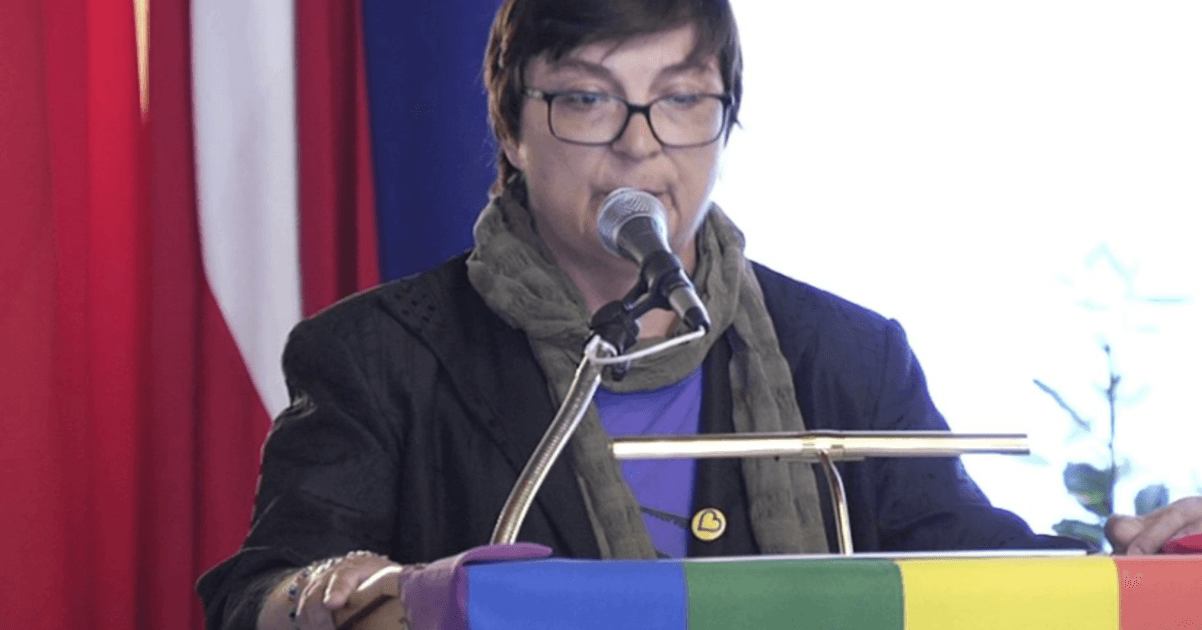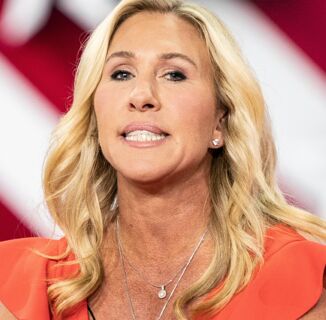Betsy Driver always felt different growing up. She just didn’t have a word for it.
Her high school in upstate Hamburg, N.Y. had a pool, and the students would often go swimming. When her female classmates would change into their bathing suits, Driver noticed that her body wasn’t like theirs. She was born with an intersex variation, meaning that her sex characteristics did not match what is typically expected of male or female infants.
After the doctors discovered a uterus and ovaries, they conducted surgery to make her body squeeze into a female box.
But Driver still didn’t fit.
“I had seen other girls,” Driver tells INTO. “Even though surgery was done on my genitals, they didn’t look like anything I was seeing on other girls in the locker room.”
Driver and her parents were never informed of that operation, and she wouldn’t learn that it was conducted until she received a copy of her medical records in the late 1990s, when Driver was in her mid-30s. She had struggled to date throughout her life, not having the words to describe what she was going through. As a teenager and then an adult figuring it all out, Driver says she “made it up as [she] went along.”
The discovery would launch two decades of advocacy work, in order to help give others the language she lacked. Driver created Bodies Like Ours, the first online support group for intersex people, in 2001. That was followed by Intersex Awareness Day, a yearly observance Driver co-founded with activist Emi Koyama in 2004.
The 53-year-old made history once more in this November’s elections: Driver was voted to the city council in Flemington, N.J., making her the first openly intersex candidate to ever win election in the United States.
When Driver takes office in 2018, she will become just one of two intersex politicians in the world to ever hold public office.
•••
But the former CBS News producer says that being intersex almost didn’t even come up in the race.
Driver, who is married to another woman, tells INTO that she didn’t “run as a lesbian or a person with intersex variation.” She entered the city council race in Flemington, which she calls “a very blue city in a very red county in a very blue state,” after a developer began targeting the town’s historic district to tear it down.
The city is home to the Union Hotel, a 19th century meeting place made famous for its role in the Lindbergh trial, which was argued at the courthouse across the street.
The once majestic building has since fallen into disrepair, and Driver hoped to represent local Democrats opposed to demolishing the landmark. After gaining a bid as a write-in candidate, she ran on furthering greater transparency in a city government she believes is run through “backroom deals.”
“It’s a really small town,” says Driver of the 1.1-square-mile city. “Typical of small towns across the country, there’s always weird political things going on.”
But during the election, a friend told Driver that her opponent planned to make an issue of her being intersex. There were rumors, she claims, that he was going to “put out a hit piece” in order to shame and embarrass her out of the race. Driver decided to neutralize the attack before it even began: On this year’s Intersex Awareness Day, she wrote a Facebook post addressing her “history as an intersex person.”
She says the response shows how far the intersex movement has come in the past 16 years.
“It became a non-issue,” Driver says. “People said, ‘Oh, that’s really brave of you.’ That’s big. In 2001, I don’t know if I would have been able to get away with that and still expect to get elected.”
Many intersex activists, though, credit Driver with helping inspire that progress.
When Bodies Like Ours was first founded in the early 2000s, there were very few resources for intersex people or spaces for individuals to discuss their experiences. Many people who were visiting the forum for the first time, which was open to the public, weren’t aware that other people went through what they did.
Hida Viloria, author of Born Both: An Intersex Life, says that Bodies Like Ours was one of “the places to meet other intersex people” prior to the advent of Facebook and Twitter.
“Over the course of many years as an activist, I’ve heard so many people say that meeting other people through Bodies Like Ours changed their life,” she tells INTO in a phone interview. “It provided not just a support space but a space for community development, where people realized that we are all suffering from this very specific institutionalized form of discrimination.”
Many of the conversations that took place on the platform were people sharing stories of genital mutilation. Communicating about the harm that forum posters experienced as young children served to illustrate the severity of the problem at a time when the movement had yet to centralize. The Intersex Society of North America (ISNA) formed in San Francisco eight years earlier, but that meeting space was largely inaccessible to individuals outside the Bay Area.
Viloria, a sexual assault survivor herself, compares the conversations that grew out of the early intersex movement to #MeToo, a hashtag campaign which gained traction following the Harvey Weinstein allegations.
Intersex Awareness Day, created three years after Bodies Like Ours went live, was a way of making these private conversations public.
“It’s a radical act of ending our oppression,” Viloria says. “It’s saying: We’re not ashamed. And we’re so not ashamed that we’re going to share who we are. We’re going to step out proudly as intersex people, even though we’re getting the message that we should never want to admit that’s what we are.”
Although the social media revolution made Bodies Like Ours obsolete, Driver says she still gets thank you notes from intersex people who found community on the platform.
“It gave hope to people,” Driver says. “They, too, were told they were the only ones out there and that they would never meet anyone else like themselves. That’s a lonely place to be to be told that, especially by doctors you’re supposed to trust. To find out you’re not alone is really a big deal.”
•••
If that platform allowed intersex people to step out of shadows, Driver’s election to the city council will bring much-needed visibility to a community fighting for representation.
“There is so much shame, stigma, and secrecy about being born with an intersex variation,” says Tony Briffa, the world’s first openly intersex politician, in an email. “I hope it will help raise awareness and help other people with intersex variations see that it is possible for us to have a successful life and be accepted by society.”
Briffa, like many children born with an intersex variation, believed growing that his life would be “bleak.” Part of what motivated his run for office, he says, was a desire to “give people hope.”
The Australian politician ran for office three times before being elected as mayor of Hobson’s Bay in 2011, a decade after Driver founded Bodies Like Ours. Briffa says that instead of being a deficit, having been born with an intersex variation made him a better representative of his constituents. His background, he tells INTO, gave him a “strong sense of social justice, a desire for fairness and to support people who don’t have a voice.”
Briffa says his community has embraced him. He has been re-elected three times, even as opponents attempted to make an issue of his intersex status. The 46-year-old claims these attacks backfired.
“They served to raise awareness about [being] intersex and increase my support base,” he says.
What makes the election of an openly intersex politician so meaningful, advocates argue, is that many people may not be aware that they know someone with an intersex variation. It’s estimated that between 1 in 1500 and 2000 children are born with neither male nor male genitalia.
In a city as small as Flemington, having Driver in office means that townsfolk are now aware that they know someone who is intersex.
But Dr. Gabriel Costello, a professor at the University of Wisconsin-Milwaukee, believes that having openly intersex people in public office is about more than visibility. They can use their public platform to be an advocate against “life-altering” surgeries intended to “normalize” an infant’s genitalia.
If one of their constituents has a child with an intersex variation, they have the ability to offer support and guidance.
“For a long time, most parents of intersex infants have had no awareness about intersexuality, and so it has occurred to few parents to push back against what doctors have told them,” he tells INTO in an email.
In Australia, Briffa’s victory served as a critical tipping point for the movement. Just two years after he was elected to the mayor’s office, the country became the first in the world to pass a standalone law prohibiting discrimination on the basis of intersex identity. In 2017, intersex advocacy organizations put out the Darlington Statement, which calls upon Parliament to criminalize non-consensual surgeries on infants.
“This is what intersex people want: the right to make our own decisions about what medical interventions, if any, will be performed on our sex characteristics,” Costello says. “And having national politicians who are intersex can move national policy in that direction.”
It’s impossible to predict what influence Driver will have in the United States. News coverage of her November win has, thus far, been quiet.
Weeks before she is set to take office, Driver tells INTO that she has the same concerns any politician does: She hopes to work for the betterment of her local community. The city councilmember-elect wants to make Flemington’s main street a destination again, the kind of place visitors go “to have an experience that isn’t available elsewhere.”
But Driver hopes that her example inspires others to make a difference, whether it’s rehabilitating a local landmark or fighting to be seen as human.
“It makes me happy and proud to know that other intersex people might see this and then have the guts to run for office themselves,” she says. “We’re learning to see the whole person: what can this person do and who can serve me best.”
Don't forget to share:
Help make sure LGBTQ+ stories are being told...
We can't rely on mainstream media to tell our stories. That's why we don't lock our articles behind a paywall. Will you support our mission with a contribution today?
Cancel anytime · Proudly LGBTQ+ owned and operated
Read More in Impact
The Latest on INTO
Subscribe to get a twice-weekly dose of queer news, updates, and insights from the INTO team.
in Your Inbox













